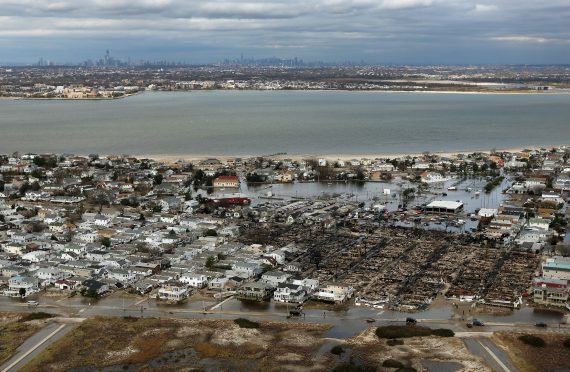The number of property owners buying flood insurance has increased significantly since Hurricane Sandy struck in 2012. Now, shifting priorities in Washington and rising coverage costs could force city homeowners to forgo flood insurance altogether or default on their mortgages if they are required to buy it.
For the past five years, the federal government has been gradually rolling back subsidies to the National Flood Insurance Program (NFIP), through which most homeowners around the country receive their coverage. This, combined with a new president who wants to cut the program by $190 million and key members of Congress calling for more private competition, has created a perfect storm of uncertainty. The current NFIP is set to expire this September, but Congress doesn’t seem close to coming up with a solution.
“There have been no actual legislative texts for a full reauthorization yet,” said Jessica Hall, a lobbyist for the National Association of Homebuilders, an industry group that is urging Congress to be cautious about burdening homeowners with new costs.
If key subsidies are rolled back, flood insurance premiums for New York City homes newly categorized as high-risk could jump from a median of $500 per year to $4,200 per year, a March study from government-funded think tank the RAND Corporation showed. To get to a more precise sense of the potential premium increases, however, you need a map.
Current insurance rates and coverage recommendations are determined by risk maps, produced and updated by the Federal Emergency Management Agency (FEMA). But the maps have not kept pace with rising sea levels and the reaches of recent disasters. When Hurricane Sandy ravaged the East Coast, these maps were badly out of date, meaning that thousands of New Yorkers who should have been insured were not.
On the surface, expanding coverage zones to vulnerable properties is a positive, but updated maps and rising prices could have a drastic impact on many property owners who were not previously considered in the same risk category. New maps would designate more than 25,000 properties in the city as high risk for the first time, according to RAND. Meanwhile, the $190 million that Donald Trump wants to cut from the NFIP would specifically defund the mapmaking, so costs would, in part, be pushed onto policyholders.
Under existing rules, newly high-risk homes can be grandfathered in at lower-risk rates. If Congress and Trump drastically roll back the NFIP, it’s unclear if any form of grandfathering will stay intact, which would be bad news for homeowners forced to buy high-risk insurance for the first time.
Congress began winding down some subsidies to the flood insurance program in 2012 through the Biggert-Waters Act. The program’s high cost — $23 billion so far — and questions about whether the government should be encouraging coastline development as climate change fears rise, has led to calls for even more reductions. Such critics argue that the NFIP subsidizes wealthy vacation homes at the expense of the inland population.
In January, Jeb Hensarling (R-TX), current chair of the House Financial Services Committee, announced that he would seek reform of the flood insurance “monopoly” and encourage private competition. While lobbyists like Hall are not necessarily against competition, they caution against a hasty shift to a privatized system, especially given the enormous costs and the uncertainty about what private insurers could realistically offer.
Caroline Nagy, deputy director for policy and research at the Center for New York City Neighborhoods, said the stereotype of beachfront mansions subsidized by the government ignores how many urban areas are categorized as high-risk flood zones.
“There’s lot of working and middle-class people living in the Rockaways and Staten Island,” she said.
Greg Sokol, a broker and president of the Staten Island Association of Realtors, said he worries that the higher rates will disqualify large numbers of potential buyers on the borough’s Eastern shore. But it could mean an uptick in one category of home shopper: cash-only buyers.
Most single-family homeowners don’t have a choice of whether to buy flood insurance or not because it’s a required term of their mortgage, but those who deal in cash can choose to forgo insurance altogether.
In Lower Manhattan, also one of the city’s highest risk zones, most condo owners pay into a building-wide plan, but in some cases they are required by lenders to purchase unit-specific policies. Rising flood insurance costs aren’t likely to tip the market one way or the other, however, according to TripleMint broker Greg Moers. “Most people purchasing in these neighborhoods don’t have restrictions on these kind of things” he said. “There’s a higher barrier to entry here.”
